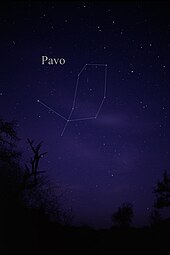Peacock (constellation)
|
Peacock constellation |
|
|---|---|
| Latin name | Pavo |
| Latin genitive | Pavonis |
| Abbreviation | Pav |
| Right ascension | 17 h 40 m 40 s to 21 h 32 m 44 s |
| declination | −74 ° 58 ′ 28 ″ to −56 ° 35 ′ 19 ″ |
| surface | 377,666 deg² rank 44 |
| Completely visible | 14.5 ° N to 90 ° S |
| Observation time for Central Europe | not observable |
| Number of stars brighter than 3 mag | 1 |
| Brightest star (size) | α Pavonis (1.94) |
| Meteor streams | |
|
Neighboring constellations ( clockwise from north ) |
|
| swell | IAU , |
|
The peacock from the Uranometria by Johann Bayer |
|
The peacock ( Latin Pavo ) is a constellation of the southern sky.
description
The peacock is a less prominent constellation west of the Southern Triangle . The main star α Pavonis is strikingly bright at
1.94 m . The other stars belong to the 3rd and 4th magnitude .
In the peacock is the conspicuous globular cluster NGC 6752 .
history
The peacock is one of the constellations introduced by Dutch navigators Pieter Dirkszoon Keyser and Frederick de Houtman at the end of the 16th century . Johann Bayer took it over in his 1603 heavenly atlas Uranometria .
Celestial objects
Stars
| B. | F. | Names or other designations | size | Lj | Spectral class |
|---|---|---|---|---|---|
| α | Peacock | 1.94 m | 183 | B2 IV | |
| β | 3.42 m | 138 | A5 IV | ||
| δ | 3.55 m | 20th | G5 IV | ||
| η | 3.61 m | 371 | K1 III | ||
| κ | 3.91 m | 544 | F2 Ib-II | ||
| ε | 3.97 m | 106 | A0 V | ||
| ζ | 4.01 m | 210 | K2 III | ||
| γ | 4.21 m | 30th | F6 V | ||
| λ | 4.22 m | 1812 | B2 II-III | ||
| π | 4.33 m | 139 | At the | ||
| ξ | 4.35 m | 420 | M1 III | ||
| ν | 4.63 m | 479 | B8 III | ||
| φ 1 | 4.75 m | 90 | F1 III | ||
| HR 7012 | 4.78 m | 95 | A7 V | ||
| ρ | 4.86 m | 195 | Fm | ||
| ο | 5.06 m | 889 | M2 III | ||
| φ 2 | 5.11 m | 79 | F8 V | ||
| ω | 5.14 m | 516 | K1 III-IV | ||
| υ | 5.14 m | 841 | B8 V | ||
| HR 7587 | 5.24 m | 302 | B9.5 IV | ||
| HR 7221 | 5.31 m | 120 | G8 / K0 III / IV | ||
| μ 2 | 5.32 m | 235 | K2 IV CN | ||
| SX | 5.34 m | 396 | M5 III | ||
| HR 7498 | 5.39 m | 135 | A4 III | ||
| σ | 5.41 m | 305 | K0 III | ||
| HR 7531 | 5.41 m | 260 | A0 IV | ||
| ι | 5.47 m | 58 | G0 V |
α Pavonis (also Peacock ( English for Peacock called)) is a 183 light-years distant, bluish shining star of spectral type B2 IV with four times the luminosity of our sun .
Variable stars
| star | size | period | Type |
|---|---|---|---|
| λ | 3.4 to 4.3 m | Irregularly changeable | |
| κ | 3.9 to 4.7 m | 9,092 days | Cepheide |
| R. | 7 to 14 m | 230 days | Mira type |
| T | 7 to 14 m | 244 days | Mira type |
λ Pavonis is a variable star 1812 light years away , the brightness of which changes with no apparent regularity.
κ Pavonis is a Cepheid- type variable 544 light-years away . Its brightness changes regularly over a period of about 9 days.
R and T Pavonis are Mira- type variables . Their brightness changes very strongly over periods of 230 or 244 days.
NGC objects
| NGC | other | size | Type | Surname |
|---|---|---|---|---|
| 6684 | 10.4 m | Galaxy | ||
| 6744 | 8.4 m | Galaxy | ||
| 6752 | 5.4 m | Globular clusters |
NGC 6744 is a galaxy 25 million light years away. In a medium-sized telescope , it appears as an oval misty spot. Impressive spiral structures can be seen in photographs.
NGC 6752 is a globular cluster 18,000 light-years away . It is the fourth brightest globular cluster in the night sky and is an impressive sight in the telescope.


